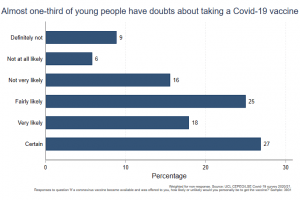Ethnicity Pay Gaps and Getting Stupid Answers
By IOE Editor, on 4 May 2021
By Paul Gregg
The old saying is that “If you ask a stupid question, you get a stupid answer”. The government-sponsored report from the Commission on Ethnic and Racial Disparities does just this on ethnic pay gaps. The central point is about comparing like-with-like when considering access to better-paying jobs in Britain. This blog post starts with a balanced assessment of what ethnic pay gaps in Britain actually look like, before explaining why the ONS analysis that the Commission draws on gets it so wrong.
Ethnic pay gaps from the Labour Force Survey
If we estimate the average (mean) pay gap between a Black, Asian, or Minority Ethnic (BAME) person and their White counterpart, living in the same region, and with similar educational achievement, using the nationally representative Labour Force Survey (LFS) of all with positive earnings, we find an ethnic pay gap of 14%. So similarly educated BAME people from the same place earn 14% less than White people. This is almost exactly the same pay gap as that found between men and women, and for those born into less advantaged families, compared to those born to more affluent families, again given the same educational achievement. The British labour market creates massive inequality of opportunity between people achieving the same education, across ethnicity, gender, and family background.
How does this compare with the Commission findings?
So the ethnic pay gap comparing like with like is 14%. So how on earth did the Commission come up with a 2.3% gap? There are two major parts to this.
The first is region people live in. The ONS report that the Commission draws on does not compare people in the same region. But ethnic minorities are not evenly spread across the country. They live disproportionately in London, the South East and major cities like Birmingham and Manchester. These are areas with higher pay but also higher living costs, especially in terms of housing costs. This 2.3% gap is comparing pay of BAME groups living in high-cost London to White populations living in low-cost Wales and the North East of England etc. This doesn’t make sense. One approach to make this more comparable would be to adjust for housing costs of where people live, but the easier approach is to compare BAME Brummies to White Brummies, and BAME Londoners to White Londoners – i.e. to compare BAME and White people living in the same region. Instead, this study gives a region-by-region breakdown of the ethnic pay gap, which is indicative of a pay gap between white and BAME groups, irrespective of where people live, of around 7%. This is one step closer to a balanced assessment but was not headline given by the Commission.
Well Paid Jobs
The second issue needs a little more explanation. Britain’s jobs have a wide distribution of pay levels. The minimum wage means that pay differences at the bottom are not that great. Pay of the person in the middle of the pay distribution was £13.68 Per Hour in 2020 (pre-pandemic). This is where ½ the employed population earn more and half less – the median. Low paid people earn between £8.50 and £9 per hour (so a little above 60% of the median). One quarter earns more than 1.5 times this median figure, 10% earn more than 3 times this, and 5% more than 7 times. In other words, there are a small minority of jobs with extremely high pay. These are in law, business, and finance predominantly.
The ONS analysis which the Commission draws so heavily on, completely ignores access to these top jobs, because it measures pay gaps using– the pay gap between the person in the middle of the White earning distribution and the middle of the BAME one. This excludes differences in access to high paying jobs from the analysis. The average based on the mean (which is what all people think of as the average) rather than median, assesses the gap across all jobs. Doing this moves the pay gap from 7% or so for people in the same regions to 13%. Surely any assessment of disparities in opportunity would include access to the elite jobs in society as well as more typical jobs. It has to – to do otherwise is just stupid. The point is well made in the report in looking at BAME groups in the Civil Service (Figure 9, p12). Across departments as a whole, about 15% of staff are from BAME groups. But in senior roles, the number is half of this. Ethnic minorities of equal educational attainment systematically do not get opportunities leading to Britain’s higher-paying jobs.
Education
Educational achievement, as highlighted by the Commission report, has been a huge success story, educational levels in the BAME community are now a little higher than in the White population. Adjusting for this too, to compare Black and White with the same education to look at disparities in opportunities, pushes the pay gap up a little further to 14%. Comparing individuals with the same education, therefore, is making very little difference to the pay gap, as you would expect. The inequalities of opportunity lie beyond education in the labour market.
Britain’s ethnic minorities are well educated but are not progressing in the labour market to the highest paid jobs. Yet a key report on ethnic disparities in opportunities chooses to assess pay gaps in a way that ignores this entirely. How stupid is that?
 Close
Close








